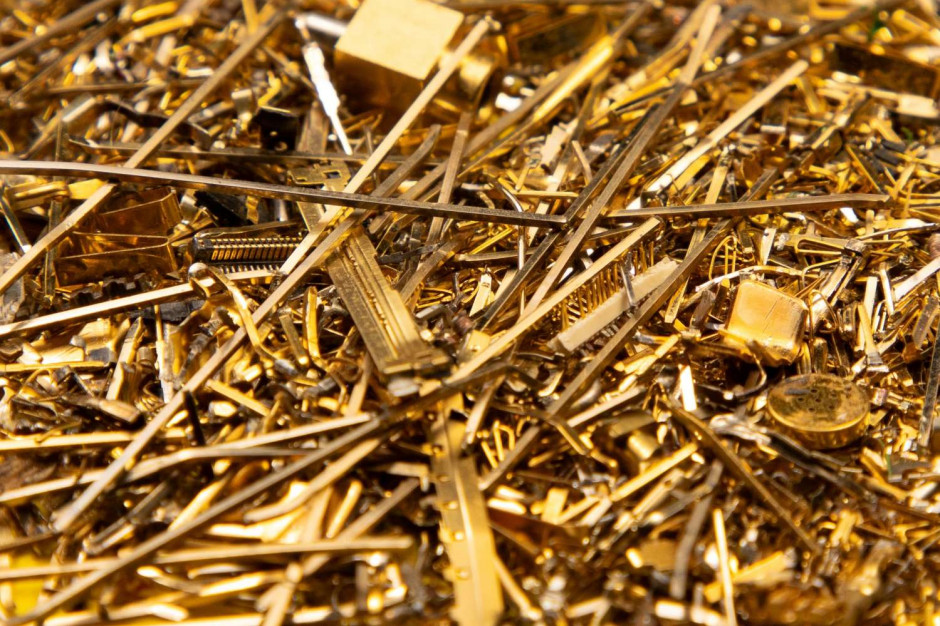GOLD RECOVERY TECHNOLOGY – Overview
Gold occurs in nature in native form (i.e., as the metal). In the past, people either collected nuggets or panned auriferous sands, where the heaviest fraction left at the bottom was gold—yet a large portion remained unrecovered. Today the approach is entirely different. To recover gold, one may either smelt the auriferous ore to obtain liquid metal (which requires a very large heat input) or extract it chemically. Modern practice relies almost exclusively on chemical methods. Historically, dissolution in aqua regia was used, but this is inconvenient because the solution is heavily contaminated with other metal cations, making purification labor-intensive. Currently, nearly selective leaching with alkaline cyanide solutions—primarily sodium cyanide (NaCN)—is used. Gold passes into solution as sodium dicyanoaurate according to:
4 Au + 8 NaCN + O2 + 2 H2O → 4 Na[Au(CN)2] + 4 NaOH
The solution can then be evaporated and smelted, separating phases to obtain liquid gold; however, a much better approach is to capture Au on a specialized ion-exchange resin, which also enables cyanide recovery for reuse in further leaching.
Equipment size:
A containerized gold-recovery station is a mobile solution that can be scaled for the final project. The unit size will be tailored to operational needs while allowing evaluation of recovery efficiency and industrial-scale operation.
Design calculations for a system with nominal flow — Qh,nom = 1.0 m³/h
Proposed Technology
We propose the use of a modern, environmentally friendly, and highly effective technology based on ion-exchange resins.
Ion-exchange resin technology
Ion-exchange resins (also called ionites or ion-exchange media) are beads of standardized diameter (typically 0.3–1.2 mm) made from synthetic polymers.
Chemically bound acidic or basic functional groups are permanently incorporated into the polymer matrix. Ion-exchange resins have the ability to exchange ions present in water: cation exchangers swap cations, and anion exchangers swap anions. Once the exchange capacity of the resin beds is exhausted, they are regenerated by passing an appropriate amount of acid or base through the bed.
Using this technology ensures high quality of the treated liquids and stable parameters. Ion-exchange resin beds effectively remove inorganic and organic contaminants present in liquids.

Station Operating Costs
Currently unknown; to be determined after conducting trials (important: influent/feed analysis) and defining the size of the system to be ordered.
AMMONIA (NH₃) RECOVERY STATION PROJECTS – GENERAL NOTES:
ore comminution => gold leaching => mechanical filtration
=> ion-exchange bed => gold recovery
1. Ore comminution: a preparatory step before the gold-leaching process. Grinding should produce powder; the finer the particles, the higher the effectiveness (yield) of gold recovery.
2. Filtration of mechanical impurities,
– mechanical filters with non-replaceable cartridges: removal of turbidity and suspended solids (bed protection), operating in automatic mode.
3. Ion-exchange columns:
– possible size: 16 x 65” (406.4 x 1651 mm)
– bed height: 1349 mm
– bed volume: 175 dm³
– max permitted flow rate: 1.0 m³/h
– linear flow velocity: 8.35 m/h
Gold recovery per column ~ 35 kg per regeneration
Note: larger exchangers can be installed, but the exact size must be specified!
Example: 63 x 86” (1600 x 2184 mm)
– bed volume: 3600 dm³
– bed height: 1793 mm
– max permitted volumetric flow rate: 18 m³/h
– linear flow velocity: 8.95 m/h (at 18 m³/h)
Gold recovery per column ~ 720 kg per regeneration.
Larger process tanks are required in such a system!!!
The system will be installed in a container (6.0 x 2.5 x 2.8 m) or a custom unit (on request, depending on the client). Inside, two process tanks of approx. 1.5–2.0 m³ will be installed with a filling system (pump and flow-control valves), mixing, and aeration. Gold-leaching from the ground ore will take place in these tanks. Ore preparation (grinding) will be performed outside the container. The concentrations of process solutions and the bath contact time will be determined during trials.
The gold-capture station is mounted on a skid, equipped with independent circulation pumps. At the inlet, two mechanical filters with cartridges for automatic washing are installed. Next, two filters in series with straight-through flow heads are installed and filled with specialized ion-exchange media. Manually actuated valves control system operation. Control valves and piping are made in chemical-resistant execution. After breakthrough of the first column, the system is switched to the second column.
After rinsing residual bath from the media, the resin beds are removed from the container. The skid frame will be made of stainless steel. Compressed air will ensure actuation/control of the leaching processes.
Day tanks and storage tanks are selected individually to match the circulating process volumes (not included in the offer). The system requires an external water supply. The offer does not include the container’s ventilation and safety systems. Staff training is not included.
Final notes:
1. The liquid leaving the ion-exchange bed during operation is an alkaline cyanide solution, which can be used to replenish the gold-leaching solution for the ore.
2. The efficiency of leaching gold from ground ore is very high—about 90% (up to ~96%), depending on process control.
3. Ion-exchange beds can capture approximately 200 g of gold (Au) per liter of resin.
Summary
An advantage of the proposed solution is the complete safety of the filtration process. Ensuring the purity of water discharged into the environment is a priority, and the filtration process is controlled at multiple stages.
Finally, depending on the Client’s needs, we obtain:
– “złocień” or “złocian” — automatic process
– gold bars with 99.99% purity — manually controlled process.
Each technology for managing or selectively treating liquids is individually developed to meet the client’s requirements. Every solution proposed by our company addresses specific loads and expected throughputs; the only constant is the highest final effectiveness.



